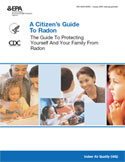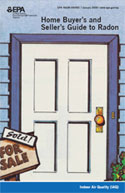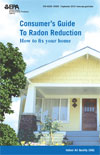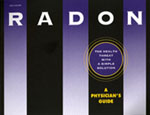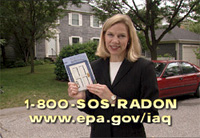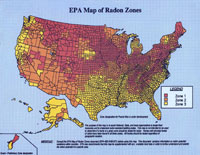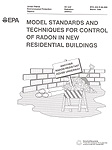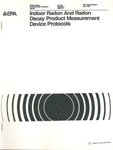Radon (Rn)
Publications and Resources
Additional Indoor Air Quality resources on Asthma, Secondhand Smoke, Schools, Large Buildings and Homes can be found at our Indoor Air Publications site.
Get the Adobe Acrobat Reader to view PDF files linked on this page. See EPA's PDF page to learn more. [En Espanol]
How to Order Publications
You can these publications from EPA's National Service Center for Environmental
Publications (NSCEP)
Website:
www.epa.gov/nscep
Phone: 1-800-490-9198 (M-F from
9 am-5:30pm eastern)
Fax: (301) 604-3408
Email:
nscep@bps-lmit.com
Use the EPA Document Number when ordering from NSCEP.
Can I Get the Files to Print Radon Publications?
EPA is offering print-ready, PC format files of the English versions of A Citizen's Guide to Radon (EPA-402/C-12/001), the Home Buyer's and Seller's Guide to Radon (EPA 402/C-09/002) and the Consumer's Guide to Radon Reduction (EPA 402/C-10/002). These files can assist you in printing your own radon publications for special events or conferences. Each free CD is complete and press-ready, including images and fonts. Use the EPA Document Numbers above to request a CD from NSCEP.
Consumers and Homeowners: Testing and Fixing Your Home
There is no known safe level of exposure to radon. EPA strongly recommends that you fix your home if your test shows 4 Pico curies (pCi/L) or more. If your test shows between 2 and 4 pCi/L, consider fixing.
| A Citizen's Guide to Radon: The Guide to Protecting Yourself and Your Family from Radon This guidance offers strategies for testing your home for radon and discussions of what steps to take after you have tested, discussions of the risk of radon and radon myths. (Note: The current version reflects corrections to links and contact information.)
Manual Informativo Sobre El Radón, La Guía para proteger a su familia y a usted del radón Esta publicación para el sitio Web es la traducción al español de "A Citizen’s Guide to Radón". Este manual le ofrece información sobre los riesgos debido a la exposición al gas radón y aclara datos acerca de los mitos existentes sobre el mismo. También encontrará estrategias para hacer la prueba de radón en su hogar y los pasos a seguir después de hacer la misma.
|
|
| Home Buyer's and Seller's Guide to Radon
This booklet is intended for anyone who is buying or selling a home, real estate and relocation professionals, home inspectors and others.
 Guía del Radon para el Comprador y Vendedor de Viviedas Guía del Radon para el Comprador y Vendedor de Viviedas
Este folleto está dirigido a cualquier persona que esté comprando o vendiendo una casa, bienes raíces y profesionales de la reubicación, los inspectores de viviendas y otros.
|
|
| Consumer's Guide to Radon Reduction: How to
Fix Your Home
You have tested your home for radon, but now what? This guidance has been specifically designed for people who have tested their home for radon and confirmed that they have elevated radon levels — 4 picocuries per liter (pCi/L) or higher. Know what to look for when selecting a qualified contractor to reduce the radon levels in your home, determine an appropriate radon reduction method and maintain your radon reduction system.
|
|
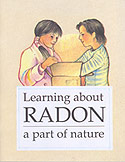 |
Learning About Radon A Part Of Nature
Written for Native Americans, this 18-page booklet discusses radon's place in the world, the basics on testing, and how homes can be fixed to reduce radon levels. Native Americans should contact their Tribal health department or state radon program office for more information.
|
|
Note: EPA no longer updates this information, but it may be useful as a reference or resource. |
|
Radon Causes Lung Cancer: the Scientific Proof
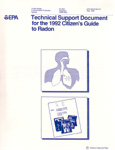 |
Technical Support Document for the 1992 Citizen's Guide to Radon
This document presents the wide range of technical analyses, radon risk communication research, legislative directives, and other information that the U.S. EPA used to shape the policies that are set forth in the 1992 "A Citizen's Guide to Radon." The document summarizes extensive technical analyses of the data that have been gathered over the past years. |
| Radon - A Physician's Guide: The Health Threat With A Simple Solution
This booklet on radon has been developed for physicians by the EPA in consultation with the American Medical Association (AMA). Its purpose is to enlist physicians in the national effort to inform the American public about the serious health risk posed by indoor radon gas.
|
Media Resources for Partners and Stakeholders
EPA’s media campaigns for TV, radio and print for use by our partners, stakeholders, collaborators and advocates. Learn more about how to view, listen to, and order radon Public Service Announcements at www.epa.gov/radon/media_campaigns.html.
Video: Breathing Easy: What Home Buyers and Sellers Should Know About Radon
The video is a visual educational tool on how to best include radon in residential real estate transactions. With a bit of light humor, the video covers the basics, including radon science, the lung cancer risk, home inspection, building a new home radon-resistant, testing and fixing a home, disclosure, state radon offices, hotline and web resources, and key radon numbers, e.g., EPA's action level and the U.S. indoor and outdoor averages. The primary audiences are home buyers and sellers, and real estate sales agents and brokers. Home inspectors, mortgage lenders, other real estate practitioners, and radon services providers will also find the video helpful.
|
|
| EPA Map of Radon Zones
The purpose of this map is to assist National, State, and local organizations to target their resources and to implement radon-resistant building codes. This map is not intended to be used to determine if a home in a given zone should be tested for radon. Homes with elevated levels of radon have been found in all three zones. All homes should be tested regardless of geographic location.
|
|
| Local Efforts to Reduce Exposure to Radon Every day in the United States someone is exposed to radon gas in their home. EPA and its partners are working to inform and educate citizens of the dangers associated with exposure to radon gas. Read about some outstanding examples and lessons learned of the successes achieved.
|
|
Builders: Building New Homes with Radon-reducing Features
Including radon-reducing features in new homes is cost-effective, and in demand by health conscious homebuyers. Some builders are installing complete fan-powered systems, especially in high radon potential areas. EPA recommends the ASTM E1465-08 standard for radon-reducing features in new homes.
| Building Radon Out: A Step-by-Step Guide on How to Build Radon-Resistant Homes
This 81-page, fully illustrated guide contains all the info you need in one place to educate home builders about radon-resistant new construction (RRNC), including: Basic questions and detailed answers about radon and RRNC; Specific planning steps before installing a system; Detailed installation instructions with helpful illustrations; Tips and tricks when installing a system, Marketing know-how when dealing with homebuyers; and, Architectural drawings.
|
|
 |
To control for radon in new residential construction,
see ASTM’s Standard Practice for Radon Control Options for the Design and Construction of
New Low-Rise Residential Buildings*.
|
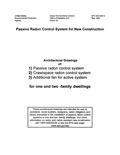 |
Passive Radon Control System for New Construction These architectural drawings are intended for use by architects, home builders, designers, radon mitigators and other interested in the installation of passive radon control systems in one and two-family dwellings. Architectural drawings of: passive radon control system; crawlspace radon control system; and additional fan for active system are available.
|
| Model Standards and Techniques for Control of Radon in New Residential Buildings
This document is intended to serve as a model for use by the Model Code Organizations, States and other jurisdictions as they develop and adopt building codes, appendices to codes, or standards specifically applicable to their unique local or regional radon control requirements.
|
Testing and Fixing Schools
- See also - IAQ Tools for Schools Program at www.epa.gov/iaq/schools
- See also - IAQ Design Tools for Schools at www.epa.gov/iaq/schooldesign
 |
Managing Radon in Schools
As part of an effective IAQ management program, schools should test for radon to know if radon levels are elevated — and if so, reduce risks to occupants through radon mitigation. Many schools have successfully applied radon mitigation strategies to control indoor radon levels.
|
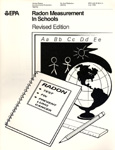 |
Radon Measurement in Schools (Revised Edition
- Second Printing)
This report was prepared to provide school administrators and facilities managers with instructions on how to test for the presence of radon. The findings from EPA's comprehensive studies of radon measurements in schools were incorporated into these recommendations. This report superseded Radon Measurements in Schools - An Interim Report.
|
 |
Radon Prevention in the Design and Construction of Schools and Other Large Buildings.
It is typically easier and much less expensive to design and construct a new building with radon-resistant and/or easy-to-mitigate features, than to add these features after the building is completed and occupied.
|
 |
Reducing Radon in Schools: A Team Approach This document will assist you in determining the best way to reduce elevated radon levels found in a school. It is designed to guide you through the process of confirming a radon problem, selecting the best mitigation strategy, and directing the efforts of a multidisciplinary team assembled to address elevated radon levels in a way that will contribute to the improvement of the overall indoor air quality of the school.
|
Technical Resources for Radon Professionals
These resources are intended primarily for professionals providing testing and mitigation services, credentialing organizations, trainers, researchers, state radon programs, and those in the broader international radon community of research and practice.
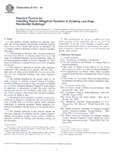 |
To mitigate radon in homes, see ASTM E2121-09 Standard Practice for Radon Mitigation Systems in Existing Low-Rise Residential Buildings* for residential radon mitigation. A single free printed copy of ASTM E 2121-09 is available from EPA upon request. Use EPA’s document number (402-K-10-007) when ordering from the
National Service Center for Environmental Publications.
ASTM E2121-09; November 9, 2009. EPA reprints E2121-09 with permission from ASTM. Copies of E2121-09 may be purchased from
ASTM International
*American Society for Testing and Materials International, or ASTMI; an American National Standards Institute, or ANSI, approved consensus standard. Note: As of May 2006, EPA's Radon Mitigation Standards (EPA 402-R-93-078, Revised April 1994) are no longer recommended or available. |
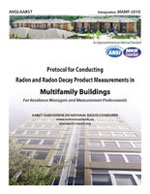 |
For measuring radon levels in multifamily
housing, see the ANSI/AARST Standard: Protocol for Conducting Radon and Radon Decay
Product Measurements in Multifamily Buildings (MAMF-2010). To purchase a copy, visit
www.aarst.org/bookstore.shtml
|
 |
Radon Reduction Techniques for Existing Detached Houses: Technical Guidance (Third Edition) for Active Soil Depressurization Systems
This technical guidance document has been prepared to serve as a comprehensive aid in the detailed selection, design, installation, and operation of indoor radon reduction measures for existing houses based on active soil depressurization techniques. It is intended for use by radon mitigation contractors, building contractors, concerned homeowners, state and local officials and other interested persons. Office of Research and Development
|
| Indoor Radon and Radon Decay Product Measurement Device Protocols
This document provides information, recommendations, and technological guidance for anyone providing measurement services using 15 radon and radon decay product measurement methods. These protocols provide method-specific technological guidance that can be used as the basis for standard operating procedures.
|
|
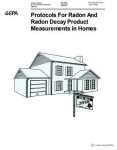 |
Protocols for Radon and Radon Decay Product Measurements in Homes
This document presents the U.S. EPA's technical guidance for measuring radon concentrations in residences. It contains protocols for measuring radon for the purpose of deciding on the need for remedial action, as presented in the 1992 A Citizen's Guide to Radon, and in the Home Buyer's and Seller's Guide to Radon.
|
| Contractor Report: Exploratory Study of Basement Moisture During Operation of ASD Radon Control Systems
(Revised March 2008)
EPA's Indoor Environments Division commissioned an Exploratory Study of Basement Moisture During Operation of ASD Radon Control Systems, under a cooperative agreement with Auburn University, Auburn, Alabama. The principal investigator was Brad Turk of Environmental Building Sciences, Inc., Las Vegas, New Mexico. The purpose of the study was to better understand the potential moisture reduction benefits from the operation of residential radon control systems. The report contains information of interest to a wide variety of audiences. Therefore, EPA is making this contractor's reports publicly available. Because these are contractor's reports, their findings, conclusions and recommendations are those of its authors, not necessarily those of EPA. The Agency believes that this information may be useful to industry associations, standard-setting organizations, government agencies and consumers. |
|
View Frequent Questions, Ask a Question
Search frequently asked questions or submit your own question or comment in our Frequent Questions Database. In addition to questions and answers relating to indoor environments, you may use this database to find information on any of our topic areas, for example, Asthma, Radon, IAQ Tools for Schools, Mold, Smoke-free Homes, IAQ Design Tools for Schools, and General Indoor Air Quality Issues. You can also use this database to subscribe to any new information or updated information relating to any of the topics that may be posted on our website.

